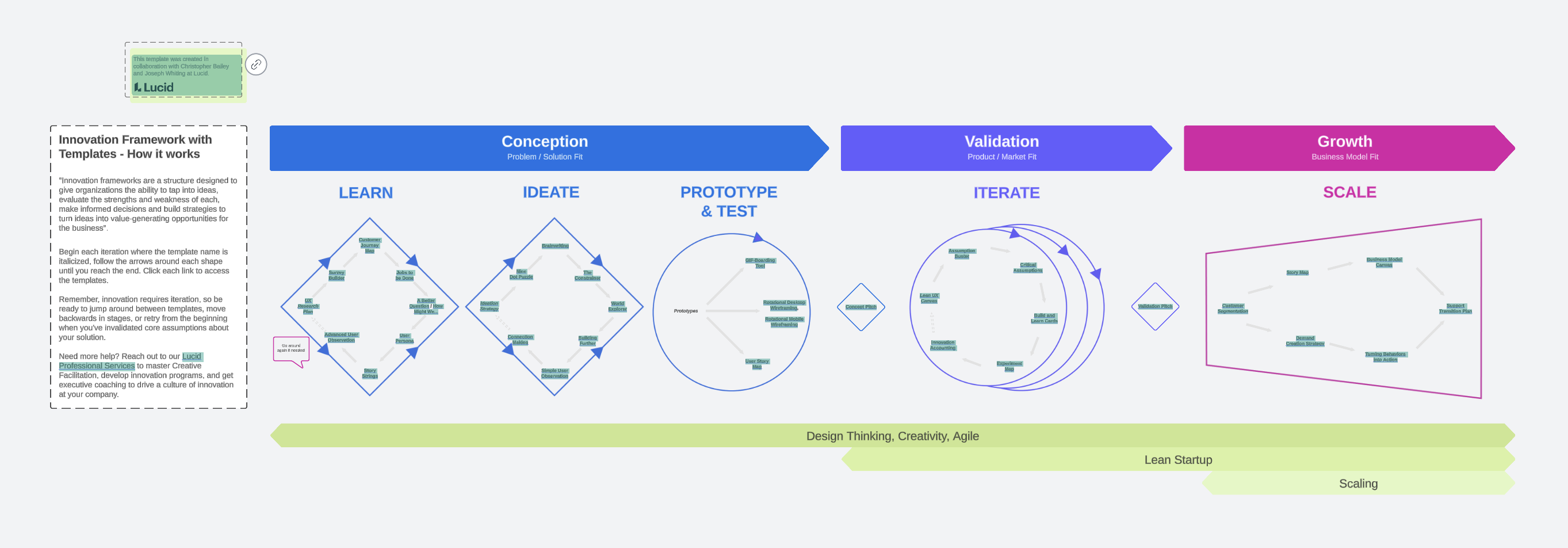
Innovation management guide: Techniques and tools to scale innovation
Reading time: about 8 min
Topics:
Innovation, by nature, comes with a ton of uncertainty. When you’re exploring new ground—maybe experimenting with emerging technology or looking into new product offerings—you have no way of knowing at the onset what benefits the tech will offer or if anyone will buy what you build.
Does that mean you shouldn’t pursue those projects? Absolutely not—but it does mean traditional project management methodologies that rely on known timelines and outcomes won’t do you any good here. (And neither will leaving innovation entirely up to chance.)
How exactly do you manage innovation projects, then? It’s not as complicated as you may think. Lucid’s Jeff Rosenbaugh, senior director of professional services, and Christopher Bailey, principal professional services consultant, have helped dozens of organizations, large and small, manage and scale innovation. We’ve distilled their years of experience into tangible innovation management tips here.
What is innovation management?
Innovation management is the process of applying oversight to an organization’s capability for generating, implementing, and measuring new ideas in order to maximize return on innovation investment. It involves a mix of cultural practices, tools, processes, and metrics to make innovation a consistent part of business.
Can innovation happen without innovation management? Sure, but it will likely be few and far between without any visibility into or control over the process.
“In short, without innovation management, you may never know why or how innovation occurred, making it a serendipity rather than a repeatable process.”
—Jeff Rosenbaugh, senior director of professional services, Lucid
Benefits of innovation management
Managing innovation is indeed trickier than managing typical projects. Those who do put in the work of formalizing their innovation management capability, though, will experience the following benefits:
- Reduced risk. With innovation management, you’ll be able to clearly see ROI and make informed decisions about whether you need to start, stop, or continue pursuing (and funding) certain projects.
- Increased transparency. A system for managing innovation provides clear KPIs that help the entire business better understand its innovative goals and progress. As such, you’ll have an easier time securing funding for projects and gaining buy-in with stakeholders across the organization.
- Stronger competitive positioning. Organizations that intentionally manage innovation and have data on what’s working will be better suited to repeat their success at scale. Innovation will become a regular, planned occurrence versus a stroke of good fortune.
How to manage innovation: 3 key elements
Without further ado, let’s uncover what it actually means to manage innovation. Just as business strategy places a focus on people, processes, and tools, so does innovation management. We’ll refer to these three elements more specifically as culture (people), portfolio management (processes), and innovation systems (tools).
#1: Innovation culture
You can think of culture as having the right conditions in place for innovation to flourish. After all, it doesn’t matter how much effort you put into processes or investment you put into tools if teams don’t feel comfortable experimenting or making decisions.
“Identify what the right values, principles, and practices are for both leaders in the space of innovation as well as individuals that are attempting to innovate,” explained Bailey.
What exactly do these principles and practices look like? Here are a few key components:
- Cross-functional collaboration: Innovation relies on trust and knowledge-sharing. Look for ways to give teams the space to connect and share findings—especially dispersed teams that don’t have a chance to connect naturally in office settings.
-
Democratized decision-making: Empower teams across the business to make decisions—and reward both those that end in success and failure. As part of this, encourage individuals to voice their dissenting opinions. (Pro tip: Visual Activities in Lucid is a great way to involve a wide range of perspectives in decisions.)
-
Collaboration equity: The best ideas come from a diversity of thought. Prioritize ways for everyone to participate in ideation and discussion regardless of their role, seniority, working location, or collaboration style.
-
Transparency: Generate engagement and excitement around innovation by keeping teams in the loop about key decisions and progress. By practicing digital-first collaboration, you’ll naturally capture this information for teams to reference as they need it.
-
Agility: Innovation is all about trying new things, learning from experiments, and adjusting based on emerging information. “It’s okay to fail. But the faster we can fail, the less investment we put into it, the better,” said Rosenbaugh.

Collaboration equity guide
Learn how to create an environment where the best ideas can emerge.
Read the guide#2: Innovation portfolio management
To properly understand which projects to invest in, you need to first understand your innovation portfolio—that is, which projects are in what stage of the innovation process, how much funding is allocated to each, and how fast each project is progressing.
While your innovation strategy will likely include a mix of core, adjacent, and transformational innovation projects, you’ll only need to manage adjacent and transformational projects. Core innovations—optimizing existing offerings and processes—are critical to your business and should occur so regularly that they don’t need to be tracked in your portfolio. “At Lucid, for example, one of our values is ‘innovation in everything we do,’” said Bailey. “We don’t necessarily need to manage these micro innovations, but we do need to encourage them.”

Want to encourage more core innovation at your org? Bailey shares how divergent thinking can help.
Learn moreHere’s how to manage your innovation portfolio:
Formalize the checkpoints for funding. While your innovation process won’t be as rigid as other business processes (you need room for experimentation!), it’s still important to identify the general steps and stages needed to bring ideas to life.
The goal is to create a clear system for how and when you’ll make decisions around funding. By standardizing when innovation projects should be evaluated, you’ll create both clarity and accountability among those leading projects.
“Let’s say a team gets to the point where they finish the discovery phase of a project and they need more funding to start building a minimum viable product. At this point, you decide if you’ll increase the investment or push back and say, ‘You need to learn a little more before we allow you to go to the next phase,��’” explained Bailey. “That's essentially what you're trying to formalize—those individual checkpoints at those different stages.”
Be sure to clarify what information teams should bring to each checkpoint. This info could include: What does the team need to learn next? How will they learn it? How much funding do they need? How many people are needed to support the next phase? We recommend providing each project owner with a template for these checkpoints to ensure consistency.

Identify key stakeholders in the decision-making process. Determine who needs to meet at each checkpoint. Be strategic about who you bring into this process to ensure they help, not hinder, your innovation efforts. Bailey and Rosenbaugh recommend thinking of the characteristics your stakeholders should exhibit in the following ways:
-
A venture capitalist: someone with the willingness and ability to connect you to either funding resources or additional talent
-
A farmer: someone who cultivates a space for growth and experimentation while providing autonomy
-
A foreign aid worker: someone who isn’t afraid to take risks and make the hard calls
-
A stockbroker: someone who is interested in the actual data
“These attributes are not options,” said Rosenbaugh. “You need to be thinking holistically to ensure that the team overseeing your innovation pipeline has all of these different traits represented.”

Learn more about the four characteristics that are essential attributes for innovation teams.
Read moreKnow what metrics you’ll track. Data is key to making informed decisions—but what metrics should you track in your innovation portfolio?
It may be tempting to jump immediately to ROI. However, bear in mind that when you’re just getting started, you should think of ROI in terms of learning, not money. “Too many times leaders are looking for an immediate return when the team has only had time to do discovery and quick prototyping with customers,” said Bailey. “What they learn from that de-risks the investments and gives clarity as to whether future bets should be made.” Note that these learnings can also add value to other innovation projects (even if the lesson came from a fail!).
“If leaders start talking monetary ROI at this stage, that will kill innovation. It's like a farmer getting mad at the corn crops because a seedling started to grow out of the ground but hasn't produced ears of corn yet.”
—Christopher Bailey, principal professional services consultant, Lucid
Here are a few examples of effective innovation metrics to get you started:
-
Number of projects in each phase of the innovation process (conception, validation, and growth)
-
Cycle time of projects in each phase
-
Average duration of projects in the pipeline
-
Rate of learning (how quickly teams are validating or invalidating assumptions)

The innovation metrics that matter
Get the guide (and dashboard template) for measuring innovation at your organization.
Check it out#3: Innovation systems
Another critical part of innovation management is ensuring you have the right systems—tooling and organizational structure—to scale innovation at your organization. The systems you have in place should answer how your business will develop products, services, or features that meet customer demand.

You’ll need the right technology in place to support the innovation process. At a minimum, your tech stack should cover the following capabilities:
-
A way to crowdsource and capture ideas, including innovation management software or virtual whiteboards.
-
A way to encourage collaboration and knowledge sharing. Email and instant messaging can work for quick updates, but we also recommend visual collaboration software to increase clarity in communication and centralize important context.
-
A way to document processes and practices, such as Confluence or Sharepoint. For visual documentation, teams can also turn to Lucid and get started quickly with templates.
-
A way to structure and understand data. Work management software or spreadsheets can be a great starting point for capturing data. To help make sense of your data, use intelligent diagramming to visualize results and unlock deeper insights.
Pro tip: Lucid fosters collaboration and alignment across the entire innovation lifecycle—including brainstorming, process documentation, knowledge sharing, data visualization, and more. With hundreds of templates, robust integrations, and advanced collaboration functionality, Lucid gives teams the structure and flexibility they need to manage innovation.

How Lucid boosts innovation
Why do teams love using Lucid for innovative projects? Find out here.
Go nowAbout Lucid
Lucid Software is the leader in visual collaboration and work acceleration, helping teams see and build the future by turning ideas into reality. Its products include the Lucid Visual Collaboration Suite (Lucidchart and Lucidspark) and airfocus. The Lucid Visual Collaboration Suite, combined with powerful accelerators for business agility, cloud, and process transformation, empowers organizations to streamline work, foster alignment, and drive business transformation at scale. airfocus, an AI-powered product management and roadmapping platform, extends these capabilities by helping teams prioritize work, define product strategy, and align execution with business goals. The most used work acceleration platform by the Fortune 500, Lucid's solutions are trusted by more than 100 million users across enterprises worldwide, including Google, GE, and NBC Universal. Lucid partners with leaders such as Google, Atlassian, and Microsoft, and has received numerous awards for its products, growth, and workplace culture.
Related articles
Guide: How to use an innovation framework to turn ideas into action
Don't leave innovation up to chance. Learn how to use Lucid’s innovation framework to make innovation a repeatable, scalable occurrence.
Why you need an innovation strategy ASAP (with tips to get started)
You can’t innovate consistently without a strategy. Uncover all the benefits and how to get started here.
10 templates to help your team create an innovation repository
Learn how to build an innovation repository, and explore 10 templates for documenting how your business brings ideas to life from ideation and planning to building and launch.
4 essential attributes your innovation team needs
Learn the four most important attributes of innovation teams and how to structure an innovation team at your company.
